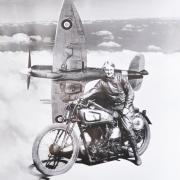Every year our Hampshire and Isle of Wight Air Ambulance crew attend to thousands of people who need help. Here we meet some of those working and volunteering for the charity who make it so special

“We all bumble along with our daily lives but suddenly an accident or incident can be life changing for someone. It’s humbling to be part of an organisation that can change a person’s life – hopefully for the better,” describes Sherie Williams Ellen, Charity Manager at the Hampshire and Isle of Wight Air Ambulance (HIOWAA). This invaluable service began in Hampshire in 2007 and since then it has saved thousands of lives and earned a special place in all our hearts. Sherie has been with the Air Ambulance for just over six years: “Like so many, I knew very little about the service at the time. I too thought it was part of the NHS, so I was surprised to find out it was entirely a charity. That’s one of our biggest challenges, to educate our local communities that we’re paid for by donation and nothing else.”
Worthwhile work
When Sherie arrived the charity was based in small offices, there were only five staff and an elderly helicopter. “Within a year-and-a-half the charity was able to upgrade to the aircraft we currently fly,” she says. “It was down to the dedication of the team and all the fundraising that we could do it so soon. We now have 16 people and we’re about to upgrade again to a brand-new helicopter.”
The support the charity receives is overwhelming - with residents across the county hosting all kinds of events to help raise money and awareness. Then there are the 120 volunteers who dedicate their time and skills to help with everything from events to speaking in schools.
Meeting all of these kind people is just one of the perks of Sherie’s job: “I enjoy the interaction with my team and the volunteers - it’s always interesting to hear people’s stories. A lot of our volunteers are ex-patients or family members of ex-patients, whose lives have changed because of the Air Ambulance.”

Challenges ahead
With the HIOWAA’s success, comes the need for more help. The aircraft at Thruxton currently costs £125,000 a month to keep flying. “The new one will be much more than that,” says Sherie. “But it can do so many more things, such as being able to fly at night using night vision.”
To help sustain its good work, the charity has been hard at work thinking of new and exciting ways to raise money and offer people great challenges, mostly overseas. “Our first one was in February, climbing Kilimanjaro. Thirty-seven fundraisers raised £173,000, which is astonishing,” Sherie says proudly. This year there’s a planned horse ride through Mongolia and next February, a team of people will be cycling through Cambodia and Vietnam.
Part of the crew - Pat Andrews, HEMS Team Leader and Paramedic describes a typical day
“It begins with the crew meeting at Thruxton and a two-and-a-half-mile run around the track. Next we put our flight suits and helmets on ready to go, before checking our control drugs, equipment and bags. Once we have left the hanger, the next task is to get the rest of equipment and take the aircraft out and onto its pad using the tractor. The pilot will start the helicopter and go through the checks and usually we’re ready to go by 8am. We will have a morning brief, where the aircrew and pilot will go through the weather reports, any limitations and notices for the day. Then we check everyone is fit to fly. Next it’s check in on the HEMS desk (Helicopter Emergency Medical Service) at Southern House in Otterbourne, and we monitor all the 999 calls which come in to the ambulance control room. We will pick out the ones that are relevant for the helicopter to be sent on, and then the paramedic will ring back the caller and get as much information as they can. If we get a call everyone has a role. The paramedic will take details of the call as well as the grid reference and plot on the map a straight line from Thruxton to the call. The pilot and doctor/paramedic will start the aircraft and we’re looking to be mobile within four minutes. I’ll be navigating the pilot to the scene while the person in the back will find a safe landing site. From there we’ll make our way to the scene, introduce ourselves to the crew and assist wherever we can with procedures. Then we need to decide whether we are going to a Major Trauma Centre (e.g. Southampton Hospital) or a Trauma Unit (e.g. North Hampshire). We’ll speak to the hospital and pass on the details of what we’re dealing with. HEMS desk then activates the helipad and we will fly in. Our average flight time has been 15 minutes. We’ll arrive, hand over to them and the patient will go on with their treatment. Then it’s on to another job, or back to base to restock our equipment.”

The Volunteer Speaker
“If I were 50 years younger, much fitter and capable of passing the training, I would give my right arm to fly that fabulous yellow helicopter which enables the medics to help so many people,” says retired electrical engineer Michael Bonathan, aged 72, from Horndean.
His road to volunteering began in 2012 when he signed up for the ‘Flight for Life Lottery’: “As a result we received a copy of the magazine, Helimed56 and in one of the articles a guy we knew was mentioned about the work undertaken by volunteers.
“Next time my wife Brenda saw him she asked for more details, and that led to me signing up later the same year.”
At first, Michael helped out at shows and placed collection tins, these days however he has found his calling in speaking to groups of all sizes and ages.
“My most memorable moment has to be giving a short talk to a primary school. The interest shown and questions which followed were quite outstanding and hopefully my efforts sowed some seeds to supporters of the future.”
The Volunteer Fundraiser
Twenty-five year old Chloe Kitching from Waterlooville became a volunteer about seven years ago: “The Air Ambulance rescued my dad following an explosion on the yacht he was renovating. He suffered 40 per cent burns and would not have made it to the specialist team at Salisbury District Hospital in time if he had travelled by land ambulance. I wanted to give something back as a ‘thank you’, and also to do something with dad in my spare time.”
Chloe helped film the promotional DVD alongside her dad, talking about his accident and why people should volunteer/donate.
“It’s a video that is used at all our volunteer inductions, and is something I am particularly proud of.”
She also helps run the eBay account, selling donations made by the public to raise money, and leads events in the county to raise awareness.
If Chloe wasn’t pursuing a career in insurance, she’d love to be a full time Community Fundraiser.
“I love the different experiences they get the opportunity to attend, and it would be great to talk about a charity I am so passionate about.”
.
To find out about the many ways you can help the HIOWAA go to their website at www.hiow-airambulance.org.uk
***
READ ON
• How the Meon Valley Trail is putting Wickham on the cycling map - The transformation of the 10-mile Meon Valley Trail is putting Wickham on the cycling map, providing accessibility for all and creating a link straight into the heart of the South Downs. Natalie French finds out more
• Hampshire Life editor Elizabeth Barnett visits Watergate Bay in Cornwall - Overlooking the magical Watergate Bay in Cornwall



























